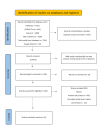Comparing Surgical Techniques for Meniscal Tears: A Systematic Review of Radiographic and Functional Outcomes
- PMID: 38283492
- PMCID: PMC10821771
- DOI: 10.7759/cureus.51239
Comparing Surgical Techniques for Meniscal Tears: A Systematic Review of Radiographic and Functional Outcomes
Abstract
Meniscal tears are a common orthopedic injury. The management approaches for meniscal tears include both surgical and non-surgical procedures; however, the majority of the surgeons opt for various surgical interventions. This systematic review aimed to compare the outcomes of different surgical techniques for meniscal tears. The systemic search was carried out in various databases including PubMed, Web of Science, CINAHL, and Scopus. Studies that investigated surgical techniques for meniscal repair and published between 2010 to 2023 were included. Out of the 7,421 potential studies identified from databases and Google Scholar search, only 17 studies were included in our systemic review. The follow-up periods ranged from 6 weeks to 123 months. Adverse effects were reported in some studies, including joint line tenderness, swelling, and loss of flexion, while others reported no significant adverse events. Pull-out repair and refixation techniques demonstrated better clinical outcomes and slower arthritic progression than partial meniscectomy. Mason-Allen stitches and simple stitches yielded comparable results, and both inside-out and all-inside techniques had similar clinical and functional outcomes. This systematic review provides valuable insights into the outcomes of different surgical techniques for meniscal tears. Further studies with longer follow-up periods may help assess the long-term effectiveness of these surgical techniques.
Keywords: arthritic changes; clinical scores; meniscal tears; orthopedic surgery; outcomes; surgical techniques; systematic review.
Copyright © 2023, Alhelali et al.
Conflict of interest statement
The authors have declared that no competing interests exist.
Figures
Similar articles
-
Modified Mason-Allen vs Two Simple Stitch Fixation for Medial Meniscus Posterior Root Tears: A Systematic Review and Meta-analysis.Am J Sports Med. 2024 Jun;52(7):1877-1887. doi: 10.1177/03635465231190650. Epub 2024 Jan 23. Am J Sports Med. 2024. PMID: 38258492
-
Arthroscopic lavage and debridement for osteoarthritis of the knee: an evidence-based analysis.Ont Health Technol Assess Ser. 2005;5(12):1-37. Epub 2005 Sep 1. Ont Health Technol Assess Ser. 2005. PMID: 23074463 Free PMC article.
-
Meniscectomy is associated with a higher rate of osteoarthritis compared to meniscal repair following acute tears: a meta-analysis.Knee Surg Sports Traumatol Arthrosc. 2023 Dec;31(12):5485-5495. doi: 10.1007/s00167-023-07600-y. Epub 2023 Oct 9. Knee Surg Sports Traumatol Arthrosc. 2023. PMID: 37812251 Free PMC article. Review.
-
Meniscus Repair in Children and Adolescents: A Systematic Review of Treatment Approaches, Meniscal Healing, and Outcomes.J Knee Surg. 2019 Jun;32(6):490-498. doi: 10.1055/s-0038-1653943. Epub 2018 May 23. J Knee Surg. 2019. PMID: 29791926
-
What Is the Failure Rate After Arthroscopic Repair of Bucket-Handle Meniscal Tears? A Systematic Review and Meta-analysis.Am J Sports Med. 2022 May;50(6):1742-1752. doi: 10.1177/03635465211015425. Epub 2021 Jun 23. Am J Sports Med. 2022. PMID: 34161741
References
-
- New strategies of meniscal tears management: a review study. Riaz A, Obeysekera D, Itani M. World J Adv Res Rev. 2021;10:33–41.
-
- A randomized trial of isokinetic versus isotonic rehabilitation program after arthroscopic meniscectomy. Koutras G, Letsi M, Papadopoulos P, Gigis I, Pappas E. https://www.ncbi.nlm.nih.gov/pmc/articles/PMC3273880/ Int J Sports Phys Ther. 2012;7:31–38. - PMC - PubMed
-
- Updates and advances in the management of lateral meniscal radial tears: a critical analysis review. Lin JS, Akers A, Miller TL. JBJS Rev. 2020;8:0. - PubMed
Publication types
LinkOut - more resources
Full Text Sources

